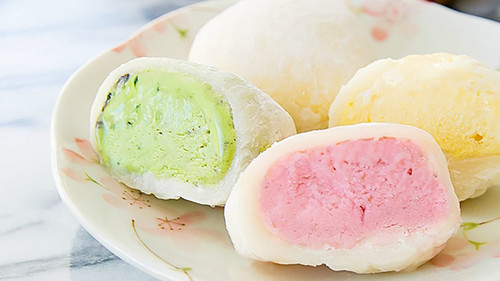Project Description
Mochi Rice Cake
Mochi——Mini glutinous rice cake
Mochi is Japanese rice cake made of mochigome, a short-grain japonica glutinous rice, and sometimes other ingredients such as water, sugar, and cornstarch. The rice is pounded into paste and molded into the desired shape. In Japan it is traditionally made in a ceremony called mochitsuki. While also eaten year-round, mochi is a traditional food for the Japanese New Year and is commonly sold and eaten during that time.
Actually the pounding process of making mochi originates from China, where glutinous rice has been grown and used for thousands of years. A number of aboriginal Chinese tribes have used this process as part of their traditions.
The first recorded accounts of mochi being used as a part of New Year’s festivities are from the Japanese Heian period. The nobles of the imperial court believed that long strands of freshly made mochi symbolized long life and well-being, while dried mochi helped strengthen one’s teeth. Accounts of it can also be found in the oldest Japanese novel, The Tale of Genji.
Though mochi is often consumed alone as a major component of a main meal, it is also used as an ingredient in many other prepared foods.
Confectionery
Many types of traditional wagashi and mochigashi (Japanese traditional sweets) are made with mochi. For example, daifuku is a soft round mochi stuffed with sweet filling, such as sweetened red bean paste (anko) or white bean paste (shiro an). Ichigo daifuku is a version containing a whole strawberry inside.
Kusa mochi is a green variety of mochi flavored with yomogi (mugwort). When daifuku is made with kusa mochi, it is called yomogi daifuku.
Ice cream
Main article: Mochi ice cream
Small balls of ice cream are wrapped inside a mochi covering to make mochi ice cream. In Japan, this is manufactured by the conglomerate Lotte under the name Yukimi Daifuku, “snow-viewing daifuku”.
Soup
Oshiruko or ozenzai is a sweet azuki bean soup with pieces of mochi. In winter, Japanese people often eat it to warm themselves.
Making a fresh milk mochi is very easy.
Ingredients
200 ml Milk (Soy milk)
30 grams Katakuriko
1 tsp Sugar
Toppings
1 As you like, such as kinako or brown sugar syrup
Steps
1.Put all the ingredients in a pan. Cook over high heat while stirring.
2.When it’s thickened, turn the heat to low. Stir swiftly. When it is getting firm, remove from the heat and let it cool.
3.When cooled, form into smaller pieces with a spoon. Sprinkle your favourite toppings such as kinako flour or brown sugar syrup.
Mochi is so soft and sticky, sometimes, with the ice cream or red bean paste filling, it is even be complicated. The out layer is glutinous while the fillings are hard, making it hard for normal knife to cut smoothly.
Ultrasonic cutting technology, with 20,000 times vibration per second on connected blade, offer a perfect cutting effect. The nano blade, which also called graphene-coated non-sticky blade, from Cheersonic especially designed for cutting something sticky like marshmallow, mochi, caramel and etc.
Cheersonic makes automated cutting solutions for all kinds of products according to customers’ demands. Ultrasonic cutting technology is advanced. We quickly adjust the size of the machine blades, and quickly portion the mochi rolls into specified size or pieces. The most important benefit is ultrasonic High-quality aesthetics brought by cutting.
Try mochi! Try ultrasonic!
About Cheersonic
Cheersonic manufactures the leading portioning equipment for bakeries producing fresh and frozen desserts. Since 1998 bakers have used Cheersonic machines to cut, slice and portion cheesecake, pie, layer cake, loaves, butter, cheese, pizza, sandwichs, and more. Cheersonic offers ultrasonic cutting solutions that support start-up bakeries and high production commercial facilities alike. Small standalone machines can be used in manual baking facilities and large inline robotic solutions aid in high speed production.
Cheersonic offers many ultrasonic slicing models, both inline and offline applications, with production speeds of 80 to 1,500 cakes or pies per hour.
Cheersonic’ latest offline introductions include ultrasonic cutting with or without divider inserts between each slice. This improves the quality of the cut and makes for a much better product presentation for the customer. In addition, robotic arm improves the speed, efficiency, and accuracy of the cutting process, producing professional looking products every time.
Chinese Website: Cheersonic Provides Professional Ultrasonic Cutting Solutions

